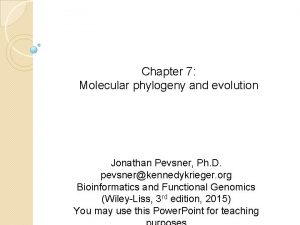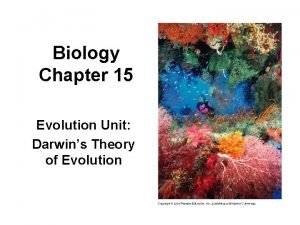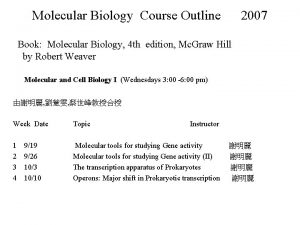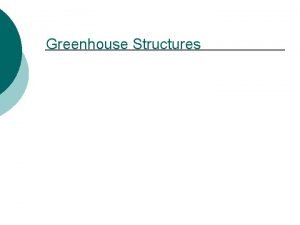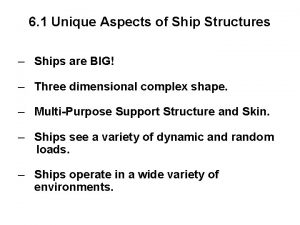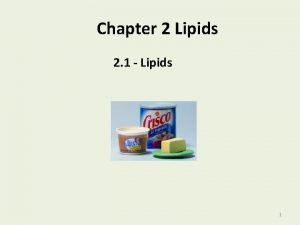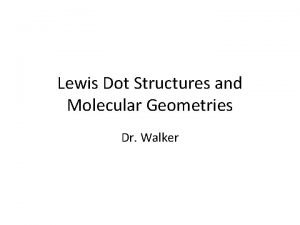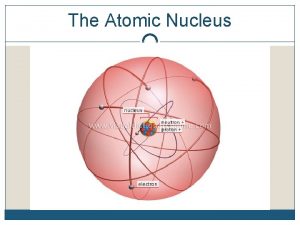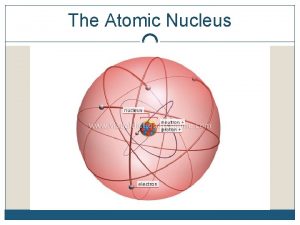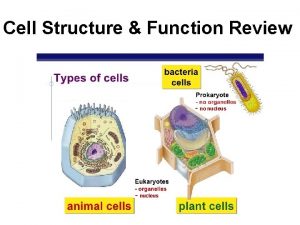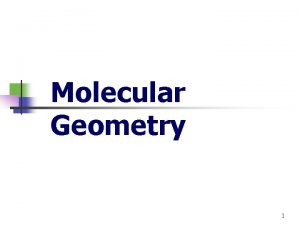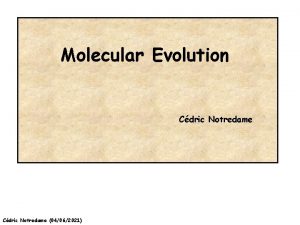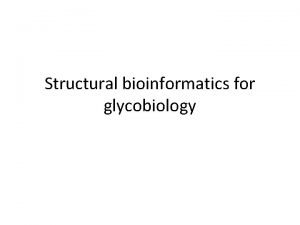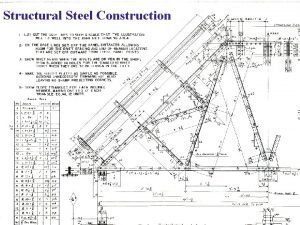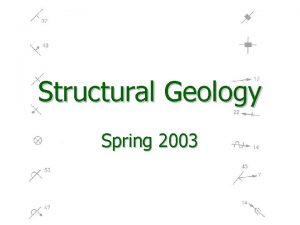OUTLINE Nucleus Evolution Structural components molecular structure and
















- Slides: 16

OUTLINE Nucleus Evolution Structural components (molecular structure and function of each component) 1. Nuclear envelope 2. Nucleoskeleton 3. Nuclear pores 4. Chromatin 5. Nucleolus 6. Sub-nuclear bodies: Cajal bodies, PIKA, PML bodies, Paraspeckles, Speckles Functions: 1. Gene expression regulation 2. Nuclear transport 3. Cell compartmentalization 4. Processing of pre-m. RNA Disease and dynamics:

The NUCLEAR COMPARTMENT nucleus or nuculeus, meaning kernel • Largest most obvious double membrane-bound cellular organelle in animals. • Dense, roughly spherical • In mammalian cells, the average diameter 6 micrometers (μm), 10% of total cell volume. • Nucleoplasm, similar in composition to the cytosol Functions as “The control center of the cell “ ümaintains the integrity of genes ü controls the cellular activities by regulating gene expression v production of other cell components v cell's growth v reproduction ……. . Enlist few other A nucleated and multinucleated cells RBC Fungi in mycorrhizae intestinal parasite, skeletal muscle, giant multinucleated cells

Evolution Models for Nuclear evolution Syntrophic Mode: a endosymbiotic relationship between ancient archaea, (modern methanogenic archaea) and bacteria (similar to modern myxobacteria) analogous to mitochondria and chloroplasts. supported by observations that • archaea and eukarya have similar genes histones. • Myxobacteria are motile, can form multicellular complexes, and possess kinases and G proteins similar to eukarya Proto-eukaryotic cells: evolved from bacteria without an endosymbiotic stage. Modern planctomycetes bacteria possess a nuclear structure with primitive pores and other compartmentalized membrane structures. A similar proposal states that a eukaryote-like cell, the chronocyte, evolved first and phagocytosed archaea and bacteria to generate the nucleus and the eukaryotic cell. viral eukaryogenesis: The most controversial model , infection of a prokaryote by a virus. Similar linear DNA strands, m. RNA capping, and tight binding to proteins (analogizing histones to viral envelopes). Exomembrane hypothesis: nucleus instead originated from a single ancestral cell that evolved a second exterior cell membrane; the interior membrane enclosing the original cell then became the nuclear membrane and evolved increasingly elaborate pore structures for passage of internally synthesized cellular components such as ribosomal subunits. Your opinion

The Structural components

Nuclear envelope Nuclear membrane, nuclear envelope, nucleolemma or karyotheca, completely encloses the nucleus, separates the cell's genetic material from the surrounding cytoplasm, serving as a barrier to prevent macromolecules from diffusing freely between the nucleoplasm and the cytoplasm. The nuclear envelope consists of 1. two nuclear membranes, arranged parallel to one another 2. an underlying nuclear lamina 3. nuclear pore complexes

Nuclear envelope The Inner membrane The inner nuclear membrane encloses the nucleoplasm, and is covered by the nuclear lamina, It is connected to the outer membrane by nuclear pores which penetrate the membranes. the inner nuclear membrane carries unique proteins that are specific to the nucleus. The outer nuclear membrane is continuous with the membrane of the rough endoplasmic reticulum (RER), and is similarly studded with ribosomes. [8] the outer nuclear membrane contains various proteins found in far higher concentrations than the endoplasmic reticulum Advantage of this structure? The space between the membranes is called the perinuclear space (It is typically about 20– 40 nm wide) and is continuous with the RER lumen.

Nucleoskeleton: NUCLEAR LAMINA Underlying the inner nuclear membrane, a fibrous meshwork within the nucleus that 1. adds mechanical support, much like the cytoskeleton, which supports the cell as a whole 2. involved in chromatin function and gene expression. • The nuclear lamina is composed of one or more related proteins called lamins. • Most mammalian cells contain four different lamins, designated A, B 1, B 2, and C. • All the lamins are 60 - to 80 -kilodalton (kd) fibrous proteins that are related to the intermediate filament proteins of the cytoskeleton.

Structural organization lamins associate with each other to form filaments 1. Two lamins to form a dimer in which the α-helical regions of two polypeptide chains are wound around each other in a structure called a coiled coil. 2. Two of these dimer structures then join side by side, in an antiparallel arrangement, to form a tetramer called a protofilament 3. Eight of these protofilaments form a lateral arrangement that is twisted to form a ropelike filament. The association of lamins with the inner nuclear membrane is facilitated by the post translational addition of lipid—in particular, prenylation of C-terminal cysteine residues In addition, the lamins bind to inner nuclear membrane proteins, which may help organize the lamin filaments into a meshwork and mediate their attachment to the membrane.

• Disassembled in a dynamic manner, meaning that changes in the length of the filament depend on the competing rates of filament addition and removal. Medical implication: Mutations in lamin genes leading to defects in filament assembly are known as laminopathies. The most notable laminopathy is the family of diseases known as progeria, which causes the appearance of premature aging in its sufferers. The exact mechanism by which the associated biochemical changes give rise to the aged phenotype is not well understood.

NUCLEAR PORE COMPLEX • Because the nuclear membrane is impermeable to large molecules, nuclear pores are required that regulate nuclear transport of molecules across the envelope. • The nucleus of a typical mammalian cell will have about 3000 to 4000 pores throughout its envelope. • Pore complex is composed of 50 to 100 different proteins collectively referred to as nucleoporins. • 125 mega Daltons in molecular weight , about 30 times the size of a ribosome • The pores are 100 nm in total diameter; however, the gap through which molecules freely diffuse is only about 9 nm wide, due to the presence of regulatory systems within the center of the pore. • Movement of large molecules such as proteins and RNA through the pores is required for both gene expression and the maintenance of chromosomes. • larger molecules must be actively transported by carrier proteins while allowing free movement of small molecules and ions. WHY: This size allows the not-free passage of small water-soluble molecules while preventing larger molecules, such as nucleic acids and larger proteins, from in-appropriately entering or exiting the nucleus. These large molecules must be actively transported into the nucleus instead.

STRUCTURE • A donut-shaped, eightfold-symmetric ring-shaped structure at a position where the inner and outer membranes fuse. • Attached to the ring is nuclear basket that extends into the nucleoplasm, and a series of filamentous extensions that reach into the cytoplasm. Both structures serve to mediate binding to nuclear transport proteins. • The central channel is approximately 40 nm in diameter, which is wide enough to accommodate the largest particles able to cross the nuclear envelope. It contains a structure called the central transporter, through which the active transport of macromolecules is thought to occur.

Transport Mechanism 1. Ran (RAs-related Nuclear protein) is involved in the transport of proteins across the nuclear envelope by interacting with karyopherins and changing their ability to bind or release cargo molecules. 2. Cargo proteins containing a nuclear localization signal (NLS) are bound by importins and transported into the nucleus. 3. Inside the nucleus, Ran. GTP binds to importin and releases the import cargo. 4. Cargo that needs to get out of the nucleus into the cytoplasm binds to exportin in a ternary complex with Ran. GTP. Upon hydrolysis of Ran. GTP to Ran. GDP outside the nucleus, the complex dissociates and export cargo is released.

FUNCTIONS OF NUCLEAR ENVELOPE 1. The nuclear envelope separates the contents of the nucleus from the cytoplasm 2. provides the structural framework of the nucleus. 3. acting as barriers that prevent the free passage of molecules between the nucleus and the cytoplasm, maintain the nucleus as a distinct biochemical compartment. 4. Phospholipid bilayers, which are permeable only to small nonpolar molecules , Other molecules are unable to diffuse through the phospholipid bilayer. 5. Nuclear pore complex sole channel, allow the regulated exchange of molecules between the nucleus and cytoplasm. 6. The selective traffic of proteins and RNAs through the nuclear pore complexes not only establishes the internal composition of the nucleus, but also plays a critical role in regulating eukaryotic gene expression.


FUNCTIONS of nucleus The function of nucleus can be estimated from the following statement. Nucleus is the storehouse of genes (genetic endowments). Production of enzymes depends upon the activities of genes. Without the production of enzymes there cannot be any metabolic activity. Genes dictate the cell to perform specialized functions such as cell division, cell sectretion, cell communication, etc. Removal of nucleus from a cell means removal of guiding entities of that cell. Therefore, without nucleus, a cell can neither survive, nor show specialized activities. peaking about the functions of a cell nucleus, it controls the hereditary characteristics of an organism. This organelle is also responsible for the protein synthesis, cell division, growth and differentiation. Here is a list of the important functions carried out by a cell nucleus. Storage of hereditary material, the genes in the form of long and thin DNA (deoxyribonucleic acid) strands, referred to as chromatin. Storage of proteins and RNA (ribonucleic acid) in the nucleolus. Nucleus is a site for transcription in which messenger RNA (m. RNA) are produced for protein synthesis. Exchange of hereditary molecules (DNA and RNA) between the nucleus and the rest of the cell. During the cell division, chromatins are arranged into chromosomes in the nucleus. Production of ribosomes (protein factories) in the nucleolus. Selective transportation of regulatory factors and energy molecules through nuclear pores. As the nucleus regulates the integrity of genes and gene expression, it is also referred to as the control center of a cell. The nucleus contains all the genetic material of an organism like chromosomes, DNA, genes, etc. Read more at Buzzle: http: //www. buzzle. com/articles/cell-nucleus-structure-and-functions. html

FUNCTIONS The main function of the cell nucleus is to control gene expression and mediate the replication of DNA during the cell cycle. The nucleus provides a site for genetic transcription that is segregated from the location of translation in the cytoplasm, allowing levels of gene regulation that are not available to prokaryotes.
 Covalent bond melting point
Covalent bond melting point Giant molecular structure vs simple molecular structure
Giant molecular structure vs simple molecular structure Giant molecular structure vs simple molecular structure
Giant molecular structure vs simple molecular structure Molecular biology evidence of evolution
Molecular biology evidence of evolution Charles darwin
Charles darwin Neutral theory of molecular evolution notes
Neutral theory of molecular evolution notes The fruit of evolution chapter 15
The fruit of evolution chapter 15 Neutral mutation
Neutral mutation Quote one topic sentence
Quote one topic sentence Molecular biology course outline
Molecular biology course outline Structural components of english spelling system
Structural components of english spelling system Gothic arch greenhouse disadvantages
Gothic arch greenhouse disadvantages Deck of cruise ship
Deck of cruise ship Glycerophospholipid structure
Glycerophospholipid structure Nuclear pores
Nuclear pores Lewis structures and molecular geometry
Lewis structures and molecular geometry Bent lewis dot structure
Bent lewis dot structure





